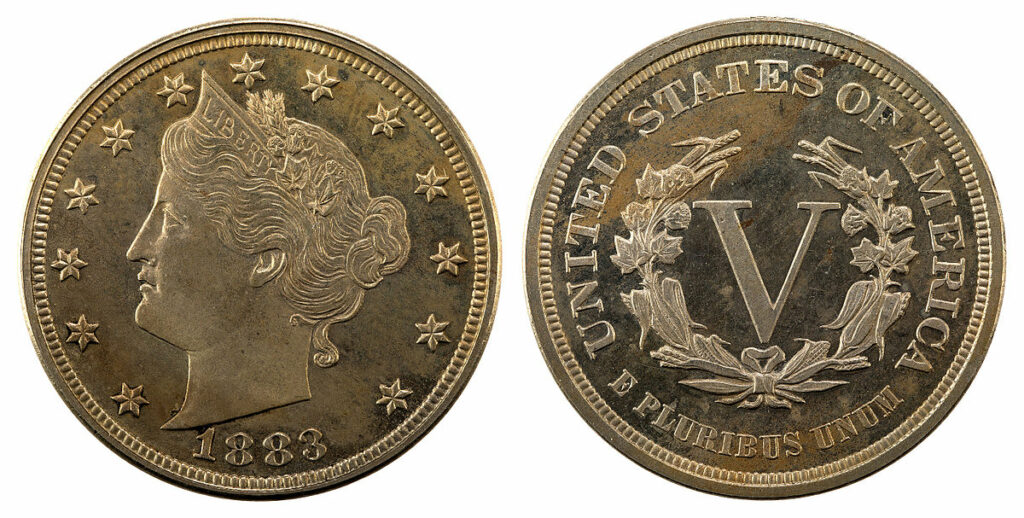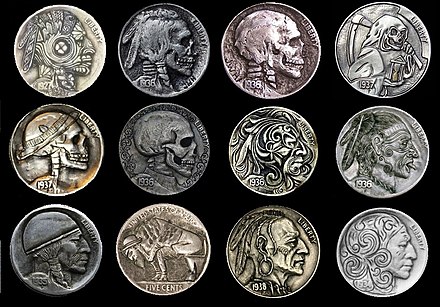Investing in a coins can be a fulfilling and potentially profitable endeavor, but it requires careful research and consideration. Nickel coins, for instance, can be valuable based on their rarity, age, condition, or specific errors during minting. What’s a good nickel coin to invest in? Alternatively, feel free to check our guide explaining what a copper coin is.
One of the most valuable US nickel coins that could be a good investment is the 1913 Liberty Head Nickel. It is extremely rare because only five specimens are known to exist. However, this coin is virtually inaccessible to most collectors due to its value, as it has been sold for millions of dollars in auctions.
A more reasonable option might be the 1880 Shield Nickel. These nickels had a very low mintage, making them rarer and more valuable than many other nickels.
Another potentially good investment is the 1950-D Jefferson Nickel. It’s the key date in the series, and while not as rare as the above examples, it is one of the most sought after by collectors.
Coins from the Buffalo Nickel series (1913-1938) can also be valuable, especially if they’re in good condition.
Remember that the specific condition of the coin (graded by professionals) can greatly influence its value, so a coin in mint or near-mint condition will be worth much more than a coin that’s heavily worn.
Before you start investing, I recommend consulting with a numismatic expert or doing thorough research on each coin’s history, rarity, and current market values. Coin collecting and investing is a field that rewards knowledge and patience, so don’t rush into any purchases without doing your due diligence.
How to Pick a Nickel Coin?
Picking a nickel coin for collecting or investment involves considering several factors. Here’s a step-by-step guide to help you make an informed decision:
- Understand your Motivation: Are you collecting for fun or are you hoping to make an investment that will appreciate over time? If it’s the former, choose coins that you find interesting. If it’s the latter, you’ll need to do some research to figure out which coins are likely to increase in value.
- Research: Learn about the different types of nickel coins that are available. In the United States, for example, there are Shield Nickels (1866-1883), Liberty Head “V” Nickels (1883-1912), Buffalo Nickels (1913-1938), and Jefferson Nickels (1938-present), each with their unique designs and histories.
- Rarity and Demand: As a general rule, the rarer the coin, the more valuable it is. Additionally, coins that are in high demand by other collectors will be more valuable. The 1913 Liberty Head V Nickel, for instance, is both extremely rare and highly sought after, making it one of the most valuable nickels in existence.
- Condition: The better a coin’s condition, the more valuable it is. Coins are graded on a scale from 1-70, with 70 being perfect. The difference between a coin graded 65 and one graded 70 can be hundreds or even thousands of dollars.
- Year and Mint Mark: Some years and mints produced fewer coins, making these coins rarer and potentially more valuable. For example, the 1950-D (Denver mint) Jefferson Nickel had a particularly low mintage and is thus more valuable than other Jefferson nickels.
- Errors: Sometimes, mistakes are made in the minting process that result in coins with errors. These error coins can be quite valuable. Look for off-center strikes, doubled dies, or re-punched mint marks.
- Purchase from Reputable Sellers: Make sure to buy from trusted coin dealers or auction sites with solid return policies and good reputations. If possible, buy coins that have been graded by a professional grading service.
- Budget: Finally, choose a coin that fits within your budget. Coin collecting can be an expensive hobby, so it’s important to set a budget and stick to it.
Remember, coin collecting and investing is a long-term endeavor. It requires patience, research, and sometimes a bit of luck. Happy collecting!
Example of Nickel Coins to Invest in
here are examples of some of the best nickel coins to consider, whether for their historical significance, rarity, or potential investment value:
- 1913 Liberty Head V Nickel: This is one of the most famous and valuable coins in the world. Only five specimens are known to exist.
- 1885 Liberty Head V Nickel: This is another rare coin, as only a limited number were minted. It can be worth a considerable amount, especially in better conditions.
- 1937-D 3-Legged Buffalo Nickel: This coin is an example of a mint error that increased the coin’s value. The buffalo appears to only have three legs due to over-polishing of the die used to mint the coins.
- 1916/16 Buffalo Nickel: This is another valuable mint error. In this case, the date was stamped twice, creating a “double die” error.
- 1950-D Jefferson Nickel: The key date in the Jefferson Nickel series. It has the lowest mintage of any coin in the series and is highly sought after by collectors.
- 1913 Type 2 Buffalo Nickel: This coin was minted in the first year of the Buffalo Nickel series. The buffalo’s mound was changed from a hill to a plain midway through the year, making the “Type 2” coin more desirable.
- 1880 Shield Nickel: Shield Nickels were minted from 1866 to 1883, and the 1880 version is one of the rarest, especially in good condition.
- 1879 Proof Shield Nickel: This coin has a very low mintage, making it quite rare and desirable.

Remember, the specific condition of each coin can significantly influence its value. Coins that are in excellent condition (with less wear and tear) will generally be worth more than the same coin in a poorer state. It’s best to seek coins that have been professionally graded and authenticated to ensure their condition and legitimacy.
Compare Nickel-Based Coins
When considering coin collecting, you have a range of options beyond just nickel coins, such as pennies, dimes, quarters, half-dollars, and dollars, each with its unique history and design. Different coins will also have different compositions, sizes, and values depending on their year, mint mark, condition, and rarity.
Here’s a comparison between different U.S. coin types:
| Coin | Composition | Size (Diameter in mm) | Common Rare Examples |
|---|---|---|---|
| Penny (Lincoln Cent) | Mostly Zinc, some Copper (Modern), mostly Copper (Pre-1982) | 19.05 | 1909-S VDB, 1943 Copper |
| Nickel (Jefferson) | 75% Copper, 25% Nickel | 21.21 | 1950-D, 1939-D |
| Dime (Roosevelt) | 91.67% Copper, 8.33% Nickel (Clad), 90% Silver (Pre-1965) | 17.91 | 1968 No S Proof, 1982 No P |
| Quarter (Washington) | 91.67% Copper, 8.33% Nickel (Clad), 90% Silver (Pre-1965) | 24.26 | 1932-D, 1976 No S Proof |
| Half-Dollar (Kennedy) | 91.67% Copper, 8.33% Nickel (Clad), 90% or 40% Silver (Specific Years) | 30.61 | 1970-D, 1964 Accented Hair Proof |
| Dollar (Eisenhower) | 91.67% Copper, 8.33% Nickel (Clad), 40% Silver (Specific Years) | 38.1 | 1972 Type 2, 1976 Type 2 No S Proof |
Please note that the “Common Rare Examples” mentioned in the table are just a few select examples and not an exhaustive list. The value of these coins varies greatly depending on the condition and specific variations (like mint errors or proof issues).
It’s important to research thoroughly before investing or collecting. While nickel coins may not typically command the same high prices as some rare dimes, quarters, or dollars, they still have a rich history and can be valuable, especially for certain rare dates or mint errors.
Conclusion
In conclusion, nickel coins can be a great starting point for both novice and experienced coin collectors and investors. They hold a rich history and offer a variety of designs, from the Shield Nickels of the 19th century to the contemporary Jefferson Nickels. Although they may not always command the high prices of some other coin types, they nonetheless have valuable and sought-after rarities, such as the 1913 Liberty Head V Nickel and the 1950-D Jefferson Nickel.
However, coin collecting and investing should not be taken lightly. It requires careful research, understanding of the coin market, knowledge about coin grading, and sometimes, a bit of luck. Make sure to purchase from reputable sellers, consider having valuable coins professionally graded, and always buy what you enjoy. After all, the joy of coin collecting often comes from the pursuit and the history behind each coin as much as from their potential financial value.
Remember, coin collecting isn’t just about financial investment—it’s also about enjoying the hobby, expanding your knowledge of history and numismatics, and being part of a community of collectors. Whether you choose to collect nickels or diversify into other types of coins, the most important thing is to enjoy the journey of building your collection.
P
